Difference Between Artificial Intelligence, Machine Learning, and Deep Learning
Introduction
Artificial Intelligence (AI) is now among the most groundbreaking technologies of our age – it influences industries, changes the way work is performed, and redefines human-machine interaction. However, AI is a constantly changing concept, and so are the nomenclature used to describe it: Machine Learning, Deep Learning, and Generative AI.
These two terms are usually used interchangeably yet they show different levels of the same eco system. Differences between Artificial Intelligence and Machine learning, and Deep learning are essential knowledge that every individual who is planning to make a career in the area must have.
The blog will cover the basics of AI & Machine Learning & Deep Learning, their uses in the real world, career prospects, and how you can begin your AI journey, despite not having any background knowledge of code.
Understanding the Basics: What is Artificial Intelligence?
Of the three concepts, Artificial Intelligence (AI) is the most generalized one. It is the simulation of human intelligence in machines that is, they are able to think, learn and make decisions in the same way that humans do.
AI systems can process data, identify trends, and form predictions or suggestions without necessarily being guided by humans.
AI can be of various types that reflect various levels of potentiality and autonomy.
The 4 Types of AI
- Reactive Machines: The least sophisticated form of AI – Reacts without memory. (Example: Deep Blue chess computer of IBM).
- Limited Memory AI: It is able to learn past information and make more informed decisions. (Example: self-driving cars).
- Theory of Mind AI: Still in research – Theories seek to learn about the emotions and thoughts of humans.
- Self-Aware AI: The highest stage -A hypothetical AI that has a human-like level of consciousness.
It is these kinds of AI that can be understood to understand the difference between Artificial Intelligence and Machine Learning and Deep Learning because ML and DL are a part of the greater AI.
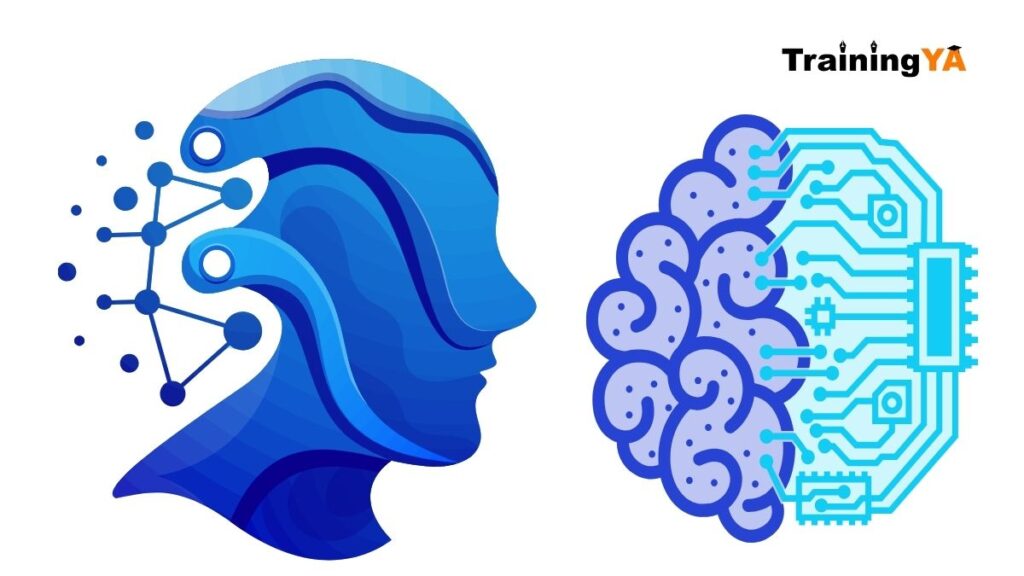
What is Machine Learning (ML)?
Machine Learning is a division of AI that is concerned with teaching computers how to learn. Unlike hard-coded rules, the pattern is identified and optimized automatically through experience by the use of ML algorithms.
For example:
- Netflix suggest movies, depending on what you have watched.
- Fraudulent transactions are being detected by credit card companies.
- E-commerce that knows what you are about to buy next.
Basically, Machine Learning gives AI its learning capabilities – that makes systems smarter as they get older.
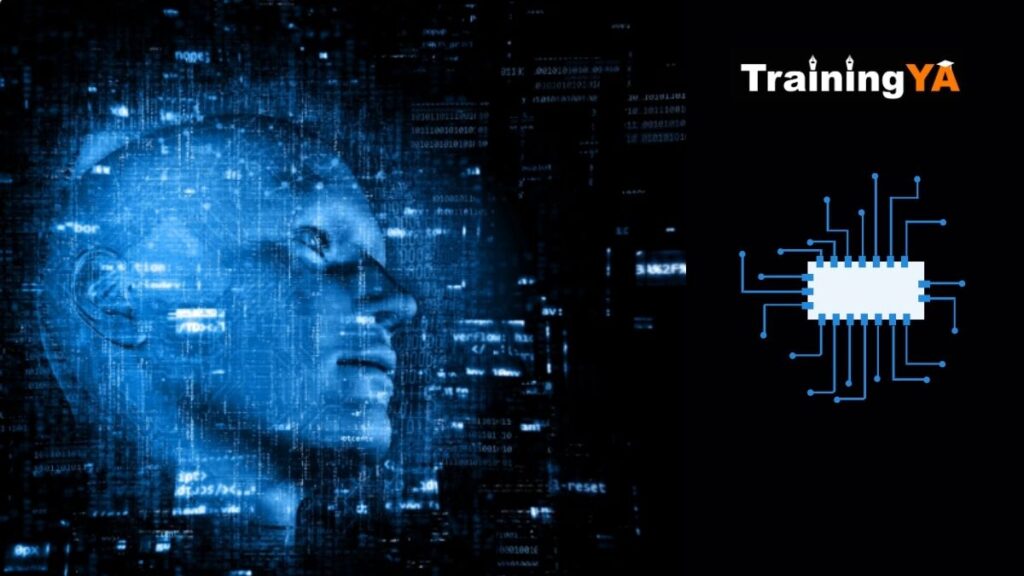
What is Deep Learning (DL)?
Deep Learning is an area of Machine Learning that is inspired by the human brain by emulating its artificial neural networks. It can take huge amounts of unstructured data, such as images, videos, and voice, and discover intricate relationships within that data.
Deep Learning powers:
- Image recognition (healthcare, automation)
- Natural Language Processing (applied in chatbots and voice assistants)
- ChatGPT and DALL·E are examples of generative AI models.
Comparing the difference between Artificial Intelligence and Machine Learning and Deep Learning, the last is the most advanced one – it can accomplish the tasks, that can be performed even by the traditional ML.
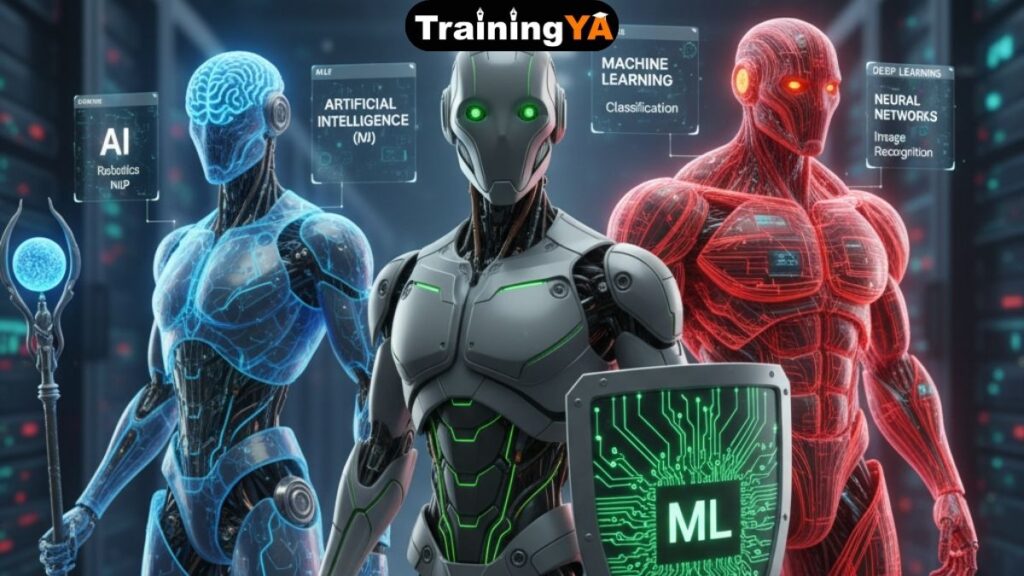
AI vs ML vs DL: The Hierarchical Relationship
To simplify:
- Artificial intelligence (AI) is the science of machine smartness.
- In AI, machines learn by means of ML.
- Machines think and learn via neural networks as humans do, through DL.
Here’s an analogy:
The whole universe is AI, the planet is ML, and a continent within it is DL.
This hierarchy can be used to explain the distinction between Artificial Intelligence and Machine Learning and Deep Learning and their respective place in the contemporary innovation.
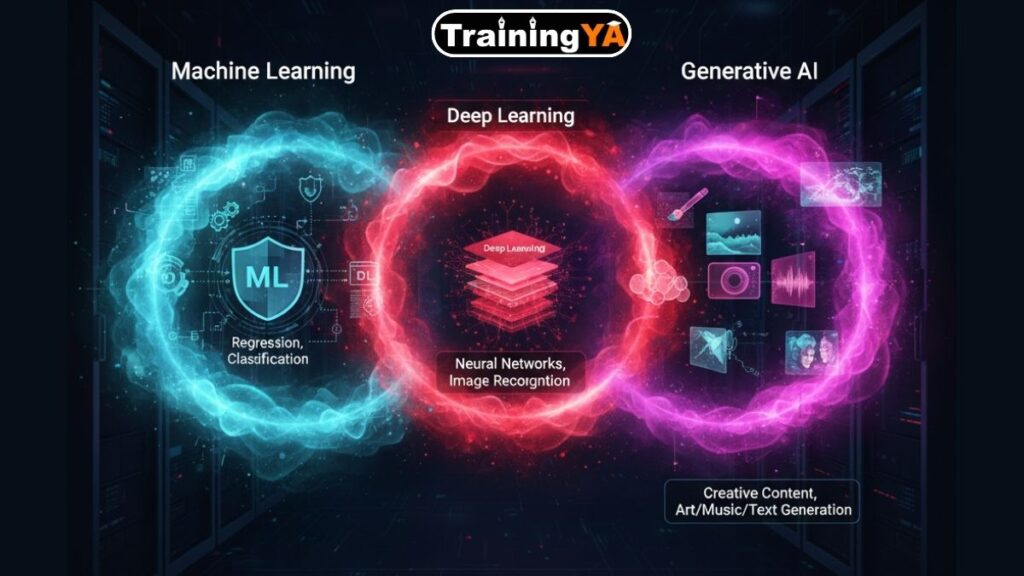
Machine Learning vs Deep Learning vs Generative AI
While Deep Learning is a subset of ML, Generative AI is an emerging field that uses Deep Learning models to create new content — text, images, music, or videos.
| Aspect | Machine Learning | Deep Learning | Generative AI |
| Definition | Learns from data to make predictions | Uses neural networks to mimic human reasoning | Uses DL to generate new data/content |
| Data Requirement | Moderate | Requires massive datasets | Massive + structured/unstructured data |
| Applications | Spam filters, recommendations | Image & speech recognition | ChatGPT, DALL·E, content generation |
| Complexity | Moderate | High | Very high |
| Hardware Requirement | Medium | GPU-intensive | GPU/TPU-intensive |
Thus, while exploring Machine Learning vs Deep Learning vs Generative AI, it’s clear that these technologies are interconnected — each advancing the possibilities of automation and creativity.
The Difference Between Artificial Intelligence and Machine Learning and Deep Learning
Let’s summarize the difference between Artificial Intelligence and Machine Learning and Deep Learning more clearly:
| Parameter | Artificial Intelligence (AI) | Machine Learning (ML) | Deep Learning (DL) |
| Definition | Broader field of simulating human intelligence | Subset of AI focused on algorithms learning from data | Subset of ML using neural networks |
| Objective | Replicate human decision-making | Enable machines to learn from experience | Simulate brain-like learning |
| Data Dependency | Not always data-driven | Data-driven | Data-intensive |
| Human Intervention | Can be rule-based | Needs human feedback | Fully automated |
| Examples | Siri, self-driving cars | Fraud detection, recommendations | ChatGPT, image recognition |
| Complexity | Conceptual | Intermediate | High |
This layered structure illustrates that the difference between Artificial Intelligence and Machine Learning and Deep Learning lies in their depth, data dependency, and autonomy.
AI in India: Growth, Adoption, and Opportunity
India is also becoming an AI innovation center in the world. The presence of government programs such as Digital India, AI for All, and the AI strategy of boosting the use of AI in the health sector, education, agriculture, and fintech.
By 2027, the AI in India market will have reached USD 17 billion with an increased CAGR of more than 20%. Machine Learning vs Deep Learning vs Generative AI models are also being used by Indian startups to develop more sophisticated automation tools and applications.
The major industries that have spurred the use of AI in India include:
- Health care: Telemedicine and predictive diagnostics.
- Finance: Algorithms and machine learning in trade.
- Retail: Customer optimization and logistics optimization.
- Education: AI tutor-powered adaptive learning.
As it continues to grow so quickly, it not only explains what sets Artificial Intelligence and Machine Learning, and Deep Learning apart, but also is crucial to individuals who want to enter the rapidly expanding AI workforce in India.
Career Scope and Salary in AI, ML, and DL
The demand for AI professionals is at an all-time high. Whether you’re a fresher or an experienced IT professional, roles in AI & Machine Learning & Deep Learning offer lucrative opportunities.
| Job Role | Average Annual Salary (INR) | Skill Focus |
| AI Engineer | ₹10 – 20 LPA | Neural networks, NLP, automation |
| Machine Learning Engineer | ₹9 – 18 LPA | Model building, data processing |
| Data Scientist | ₹8 – 15 LPA | ML algorithms, business analytics |
| Deep Learning Specialist | ₹12 – 25 LPA | CNNs, NLP, GANs |
| Generative AI Developer | ₹15 – 30 LPA | LLMs, prompt engineering |
Globally, AI roles often exceed $120,000 per year, making it one of the most rewarding career paths in tech.
Who Can Enroll in AI & Machine Learning & Deep Learning Courses?
AI does not only concern coders or graduates in technology. Any businessperson who is curious and analytical can choose this way.
Ideal Candidates Include:
- Graduates in engineering or computer science.
- Professionals working in the area of IT, analytics, or business.
- Students not technical but one who is interested in data-driven work.
- Businesses that would like to automate or be innovative with AI.
In TrainingYA, programs are created at every level of skill, such as those who desire to understand How to Start a Career in Artificial Intelligence with No Coding Background.
Calculating intricate ideas through visual learning tools, AI-powered laboratories, and projects that any person can easily follow, we make AI available to all.
Benefits of Learning AI, ML, and DL
1. High Career Demand
AI experts are among the five most in-demand positions in the world. Artificial intelligence-based decision-making is being incorporated in all industries, including healthcare and e-commerce.
2. Future-Proof Skillset
As the AI turns out to be the cornerstone of future automation, by learning it, you guarantee that your occupation will be topical.
3. Interdisciplinary Application
AI can be applied to several sectors such as business, finance, marketing, and design, and AI creates new employment opportunities beyond the usual technology-related jobs.
4. Global Opportunities
This is a globally acknowledged skill with Google, Microsoft, TCS, and Amazon among the world leaders aggressively recruiting AI experts.
How to Start a Career in Artificial Intelligence with No Coding Background
There is no reason to be a hardcore programmer to start in AI. A lot of successful people are business, design, or even humanities people.
Here’s a roadmap for beginners:
- Understand the Basics: Learn what AI, ML, and DL are — and the difference between Artificial Intelligence and Machine Learning and Deep Learning.
- Take a Beginner-Friendly Course: Join a structured program (like TrainingYA’s AI & ML course) designed for non-coders.
- Learn Tools Before Code: Start with visual AI tools like Google AutoML, Teachable Machine, or KNIME.
- Build Small Projects: Work on mini projects — sentiment analysis, image classification, or chatbots.
- Transition Gradually to Coding: Learn Python basics once comfortable with the concepts.
Through mentorship, one can even be in the AI field with no technical background whatsoever, and can even graduate into higher positions in AI and Machine Learning and Deep Learning.
The Future of AI & Generative Technology
The AI ecosystem has been given a new dimension by generative AI. AI generation has been proven to work by ChatGPT, Bard, and Midjourney, among other models.
With industries moving towards the use of Machine Learning vs Deep Learning, vs Generative AI systems, the future employees will have to comprehend both analytical and creative aspects of AI.
The fact that AI is applied in all the business functions, including HR, marketing, logistics, and design, predetermines the ongoing necessity for trained specialists who know the difference between Artificial Intelligence and Machine Learning, and Deep Learning, and who can make creative use of it.
Conclusion
Artificial Intelligence is not a Phantom of the Opera but the present-day reality, which influences all spheres of life. However, to fully grasp its power and use it, one must understand the difference between Artificial Intelligence, Machine Learning, and Deep Learning.
The mind is AI, the learning process is ML, and the depth of intelligence that humanizes machines is DL. AI combined with Machine Learning and Deep Learning is the triplets of contemporary innovation.
As the AI ecosystem in India has been thriving and the world is seeking a highly skilled workforce, this has never been a better time to begin your Artificial Intelligence career, despite your question of, How to Start a Career in Artificial Intelligence with No Coding Background.
At TrainingYA, we assist learners at all stages to learn these skills through real-world projects, expert guidance, and placement services to transform curiosity into a career.
The intelligent future begins with a concept of the distinction between Artificial Intelligence, Machine Learning, and Deep Learning.
Frequently Asked Questions
ChatGPT is created based on Deep Learning and Generative AI models. It belongs to a larger group of Artificial Intelligence, where ML algorithms and neural networks are used to process and generate human-like text.
- AI (Artificial Intelligence): The art of smart machines.
- ML (Machine Learning): How machines learn.
- DL (Deep Learning): This is a branch of ML that involves neural networks in higher-order pattern recognition.
- DS ( Data Science): The art of data analysis and interpretation until a decision is made.
The four are all intertwined – being not only informed on the distinction between Artificial Intelligence and Machine Learning, and Deep Learning, but also on which side Data Science is positioned in this ecosystem.
The types of AI are:
- Reactive Machines
- Limited Memory
- Theory of Mind
- Self-Aware AI
They are all a form of intelligence, the self-aware AI being the most advanced type, and it is at the research phase.
AI is the more general discipline, and MC is a specific division of AI. Nor is any better, then, ML belongs to AI. Nevertheless, in practice, to enter the AI ecosystem, ML is a better place to start to have a job opportunity.
It depends on your goal.
- ML is ideal in smaller datasets and traditional analytics.
- DL is very good at dealing with complex and big data, such as speech or images. Each of them complements the other; to have a beneficial effect it is necessary to know their synergy to master the distinction between Artificial Intelligence and Machine Learning, and Deep Learning.








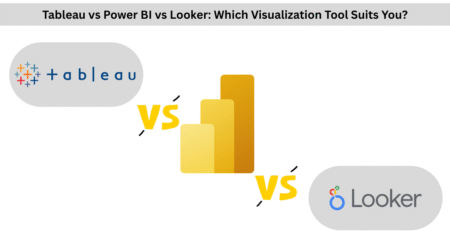




Leave a Reply